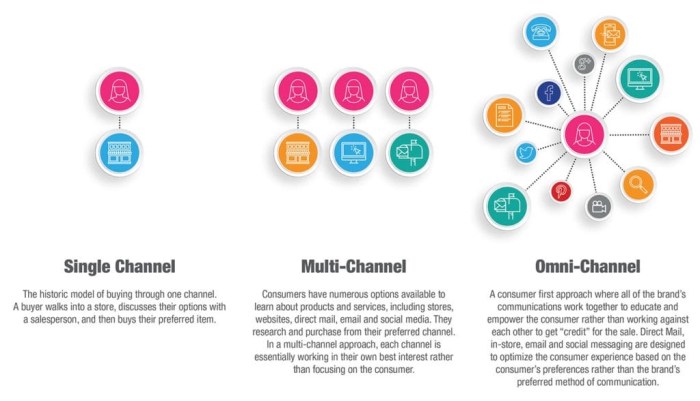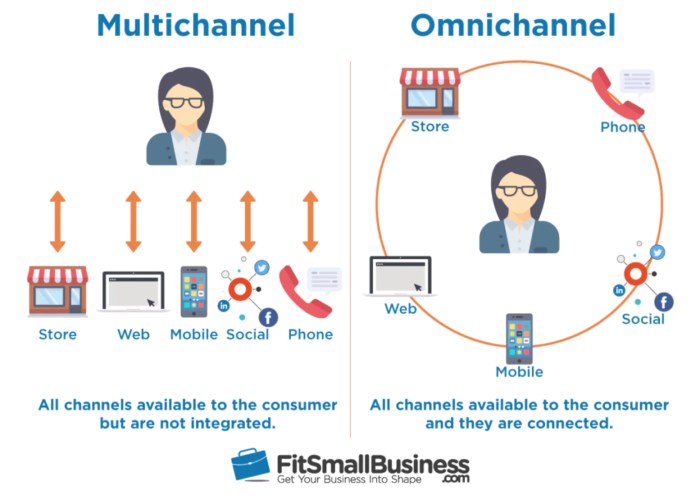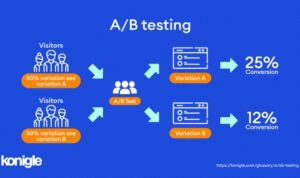Developing an Omnichannel Marketing Strategy takes center stage, inviting readers into a world of modern business tactics and customer engagement. Get ready to dive into the realm of creating cohesive brand experiences across various channels!
In this guide, we’ll explore the essential steps and best practices for integrating social media, email, websites, and physical stores to deliver personalized marketing messages that resonate with your audience.
Understanding Omnichannel Marketing
Omnichannel marketing is a strategy that focuses on creating a seamless and integrated shopping experience for consumers across multiple channels, both online and offline. This approach ensures that customers can interact with a brand through various touchpoints, such as websites, social media, mobile apps, physical stores, and more.
Examples of Successful Companies
- Amazon: Amazon provides a consistent experience for customers whether they shop online, through their mobile app, or in physical Amazon Go stores.
- Starbucks: Starbucks allows customers to earn rewards and make purchases through their app, website, in-store, or even through delivery services.
- Nike: Nike offers a seamless shopping experience across their website, mobile app, and physical stores, providing personalized recommendations and exclusive offers.
Benefits of Omnichannel Marketing
- Improved Customer Experience: Omnichannel marketing ensures a consistent and personalized experience for customers, leading to increased satisfaction and loyalty.
- Increased Sales: By providing customers with multiple channels to interact with a brand, businesses can reach a wider audience and drive more sales.
- Data-driven Insights: Omnichannel strategies allow businesses to gather data from various touchpoints, providing valuable insights into customer behavior and preferences.
Developing a Comprehensive Omnichannel Strategy

In today’s digital landscape, developing a comprehensive omnichannel strategy is crucial for businesses to reach their target audience effectively. By integrating various channels such as social media, email, websites, and physical stores, companies can create a seamless and personalized experience for their customers. This not only enhances customer engagement but also boosts brand loyalty and drives sales.
Here are the steps involved in developing a holistic omnichannel marketing strategy:
Integrating Various Channels
When integrating various channels into your omnichannel strategy, it is important to ensure consistency and coherence across all platforms. Here are some best practices to keep in mind:
- Sync messaging and branding across all channels to maintain a cohesive brand identity.
- Utilize data analytics to track customer interactions and preferences across different channels.
- Provide a seamless shopping experience by enabling customers to switch between online and offline channels effortlessly.
- Optimize your website and social media platforms for mobile devices to cater to the growing number of mobile users.
Personalizing Marketing Messages, Developing an Omnichannel Marketing Strategy
Personalization is key to enhancing customer engagement and driving conversions. Here are some strategies to personalize marketing messages across different channels:
- Segment your audience based on demographics, behavior, and preferences to deliver targeted content.
- Use customer data to create personalized product recommendations and offers.
- Implement dynamic content that adapts to customer interactions in real-time.
- A/B test different messaging strategies to determine the most effective approach for each channel.
Leveraging Data and Analytics: Developing An Omnichannel Marketing Strategy
Data and analytics play a crucial role in optimizing an omnichannel marketing strategy by providing valuable insights into customer behavior, preferences, and interactions across various channels. By leveraging data-driven decision-making, businesses can tailor their marketing efforts to meet the needs of their target audience more effectively.
Role of Data and Analytics
- Customer Segmentation: Data analytics tools help in segmenting customers based on demographics, behavior, and preferences, allowing for personalized marketing strategies.
- Performance Tracking: Analyzing data from different channels enables businesses to track the performance of their marketing campaigns in real-time and make necessary adjustments for better results.
- Predictive Analytics: By using predictive analytics, businesses can forecast future trends and customer behavior, allowing for proactive marketing strategies.
Tools and Technologies for Data Collection and Analysis
- Customer Relationship Management (CRM) Systems: CRM systems collect and store customer data, providing valuable insights for personalized marketing campaigns.
- Web Analytics Tools: Tools like Google Analytics track website traffic, user behavior, and conversion rates, helping businesses understand customer interactions online.
- Marketing Automation Platforms: Automation platforms like HubSpot or Marketo automate marketing processes and analyze customer data for targeted campaigns.
Examples of Data-Driven Insights in Marketing Campaigns
- Personalized Recommendations: E-commerce websites use customer purchase history and browsing behavior to recommend products, increasing sales and customer satisfaction.
- A/B Testing: By analyzing data from A/B tests, businesses can determine which marketing messages or designs resonate best with their audience, leading to improved campaign performance.
- Optimized Ad Targeting: Social media platforms use data analytics to target ads to specific audience segments, increasing ad relevance and engagement.
Creating Consistent Brand Experience

Maintaining a consistent brand experience across all channels is crucial for building customer trust and loyalty. It ensures that customers receive the same messaging, quality, and service regardless of how they interact with your brand.
Importance of Consistency
Consistency in branding helps in establishing brand recognition and recall among consumers. When customers encounter a consistent brand experience across various channels, it reinforces the brand image and fosters trust. This trust can lead to increased customer loyalty and advocacy.
- Ensure brand guidelines are clearly defined and communicated to all team members involved in marketing and customer interactions.
- Regularly audit all touchpoints to ensure they align with the brand’s messaging, tone, and visual identity.
- Use a centralized system for managing brand assets to maintain consistency in design elements, logos, and brand voice.
- Solicit feedback from customers to gauge their perception of the brand experience and make necessary adjustments to enhance consistency.
Aligning with Brand Values
To align the omnichannel strategy with the brand’s core values and identity, it is essential to integrate these values into every aspect of the customer journey. By infusing brand values into messaging, product offerings, and customer interactions, you can create a cohesive brand experience that resonates with your target audience.
- Identify the core values that define your brand and ensure they are reflected in all marketing communications.
- Train employees to embody these values in their interactions with customers, both online and offline.
- Create brand personas that embody the brand values and use them as a guide for developing marketing campaigns and content.
- Consistently reinforce brand values through storytelling and content that highlights how the brand makes a positive impact on customers’ lives.
Implementing Seamless Customer Journeys
Creating seamless customer journeys in an omnichannel environment is crucial for providing a consistent and personalized experience to customers. By ensuring that customers can move effortlessly between different channels while maintaining their preferences and information, businesses can enhance customer satisfaction and loyalty.
Mapping Customer Touchpoints
- Identify all the touchpoints where customers interact with your brand, including social media, websites, mobile apps, and physical stores.
- Map out the customer journey from awareness to purchase to post-purchase support, highlighting key interactions and pain points.
- Use data and analytics to understand customer behavior and preferences at each touchpoint, allowing for more targeted and personalized communication.
Optimizing User Experience
- Ensure a seamless transition between channels, allowing customers to pick up where they left off regardless of the platform they are using.
- Streamline processes and reduce friction points to make the customer journey as smooth and efficient as possible.
- Personalize the experience based on customer data, providing relevant recommendations and offers at each touchpoint.
Automation and AI in Customer Journeys
- Implement chatbots and virtual assistants to provide instant support and guidance to customers across channels.
- Use AI algorithms to analyze customer data and predict their next actions, allowing for proactive engagement and personalized recommendations.
- Automate marketing campaigns and communication to deliver the right message to the right customer at the right time, increasing engagement and conversion rates.












